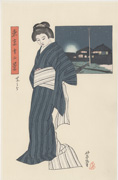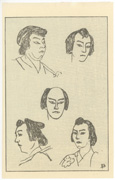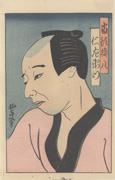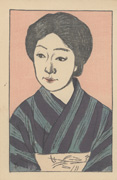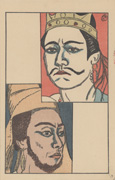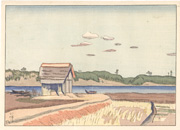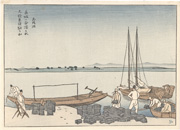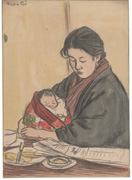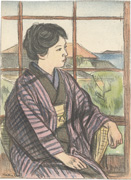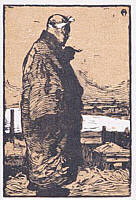Prints in Collection
Shibaura from the series Twelve Views of Tokyo, c. 1914-1917
IHL Cat. #1229
Issue 2
Sketches of Five Actors, 1915
IHL Cat. #848Issue 2
Kataoka Nizaemon in the role of Gonpachi, 1915
IHL Cat. #1979Issue 3
Kiyoko as Akagashi Mitsue, 1915
IHL Cat. #1373Issue 3Ennosuke in the role of the exiled king and Tōzō in the role of warrior priest Kōku, 1915
IHL Cat. #256 and #1483
Exhibition (untitled)
c. 1910-1920
IHL Cat. #1601
Woman holding baby (untitled)
c. 1910-1920
IHL Cat. #1602
IHL Cat. #1603
Biographical Data
Biography
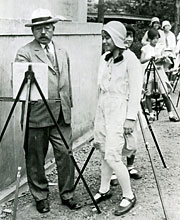 Ishii Hakutei (undated photo) | Ishii Hakutei, painter, print artist and art critic, was one of the fathers of the sosaku hanga (creative print) movement. Born in the Shitaya area of Tokyo in 1882with the given name Mankichi, he was the son of the traditional-style painter and lithographer Ishii Teiko (1848-97), with whom he studied early in his life. After his father's death, Hakutei became interested in Western-style art and soon became very competent in both oils and watercolor, specializing in Japanese landscape. During 1898-1899 he studied under Asai Chū (1856-1907), a leading Western-style (yoga) painter and a founding member of the Meiji Bijutsukai (Meiji Fine Arts Society) and, after Asai's leaving for Europe, with Nakamura Fusetsu (1866-1943).1 In 1904 he won entry to the Tokyo School of Fine Arts, where he studied with Kuroda Seiki (1886-1924) and Fujishima Takeji (1867-1943) both prominent Western-style painters. Ishii was an activist in groups of Western-style artists. He was the editor of the art and literary magazine Myōjō (Morning Star), which published reproductions of Western art along with woodblock print reproductions of young Japanese artists, and a co-founder of the magazine Heitan (1905-1906). |
In July 1904, Ishii published Yamamoto Kanae's (1882-1946) print Fisherman (shown below). Fisherman was called a "revolutionary step" by Ishii because Kanae had personally done all the work in producing a print from his own design, as opposed to the long-established practice in which the functions of artists were presumed to be distinct from those of artisans, i.e. the artist did the design and relied upon artisan carvers and printers, generally working for a publisher, to produce the final print.2
On the 16th of June, my friend Yamamoto Kanae produced a painter's woodcut with his talents in wood engraving and painting. The knife was his brush. - Ishii Hakutei [fn.3]
From 1907 to 1910 Hakutei co-founded and was chief editor of the magazine Hōsun 方寸, where many of his paintings were published in reproduction and where his ideas on the development of Japanese art were put forward. He also took part in the literary group Pan no kai, formed in 1909, which "tried to emulate the atmosphere of artists gathering in Parisian cafes."7 He went to Europe in 1910 and lived in Paris from 1911 to 1912.8 On his return in 1912 he continued his prints series Twelve Views of Tokyo (see below), begun in 1910. Ishii wrote extensively on the European art scene and his experiences, reporting on the Fauve, Futurist, and Cubist exhibits he viewed overseas, as well as on Kandinsky and the Blauer Reiter group.9
In 1915, Hakutei contributed a number of portraits of kabuki actors to Shin Nigao Magazine whose purpose was to advertise the Kabuki theater and renew interest in actor prints. (See prints IHL Cat. #243 and #256.)
The fact that Hakutei did not participate in the founding of the Japanese Creative Print Association in 1918 suggests his interest had returned firmly to painting, where it remained. He went again to Europe in 1923-25.
The Print Series "Twelve Views of Tokyo"
In 1910, Hakutei began designing a series of prints called Twelve Views of Tokyo (Tokyo jūnikei 東京十二景), which have become the woodblock prints he is best known for, even though they drew little interest when first published. Their lack of sales resulted in only nine of the twelve planned designs being created.
Each print featured a traditionally dressed woman in front of a picture of a modern Tokyo scene with a cartouche containing the title of the series, in a style popular in later ukiyo-e prints. Hakutei's friend, Igami Bonkotsu, carved the blocks and they were printed by Nishimura Kumakichi. Two prints, Yoshicho (pictured below) and Yanagibashi, were completed in 1910, before his sojourn to Paris, and the last seven prints were made after his return to Japan in 1914. At least the first two prints were published by the artist Takamura Kōtarō (1882-1956) who opened Japan's first picture gallery in April 1910 after returning from studying in the U.S. and Europe.
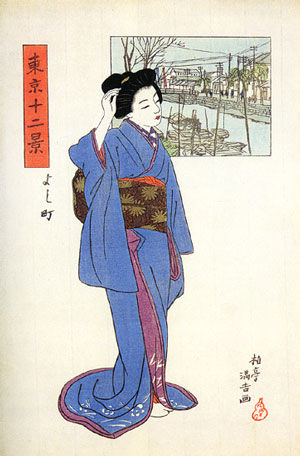
from Twelve Views of Tokyo
4 op. cit. Modern Japanese Woodblock Prints
5 Ibid.
9 In Pursuit of Universalism: Yorozu Tetsugoro and Japanese Modern Art, Alicia Volk, University of California Press, 2009, p. 35.
last revision:
